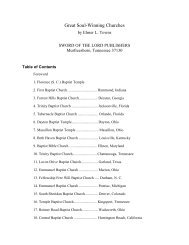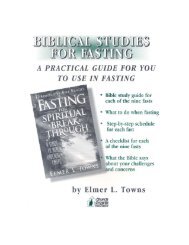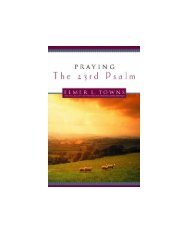PUTTING AN END TO WORSHIP WARS - Elmer Towns
PUTTING AN END TO WORSHIP WARS - Elmer Towns
PUTTING AN END TO WORSHIP WARS - Elmer Towns
- TAGS
- worship
- elmer
- towns
- elmertowns.com
You also want an ePaper? Increase the reach of your titles
YUMPU automatically turns print PDFs into web optimized ePapers that Google loves.
esistance in the church when he is perceived as doing too much. He probably works harder at<br />
more different things than pastors of non-congregational churches, but certain areas of ministry<br />
belong to the people. They expect to be involved in the planning of special events in the life of<br />
the church such as church anniversaries and Christmas programs. And they expect everyone will<br />
have some role as these times are celebrated together.<br />
THE BONDING AGENT OF THE CONGREGATIONAL CHURCH<br />
The Congregational Church differs from other worship styles in that there is no single<br />
spiritual gift glue that bonds members to one another. Rather, most Congregational Churches<br />
could be described as single cell churches. This is a church where everyone knows everyone,<br />
everyone relates to everyone, and everyone waits on everyone before anyone will do anything.<br />
Although a single cell church can be stretched, the size of a Congregational Church is usually<br />
limited to the number of persons who can relate well to everyone else. Various church growth<br />
writers suggest a cell can grow to forty to sixty-six members. Beyond those limits, cells cease to<br />
function well.<br />
The Congregational Church may be the most common worship style among American<br />
churches today. Statistical research suggests at least half of the churches in America are<br />
composed of fifty members or less. That percentage rises to about seventy-five percent when the<br />
upper limits of single-cell growth are considered. Most of these churches could probably be<br />
described as Congregational Churches.<br />
Although there may be more Congregational Churches than other types, the size and<br />
nature of these churches hinders the rise of dominant leaders within the movement. In a single<br />
cell church, the pastor who is a member of the church is often on the outside of the cell. It is not<br />
uncommon for pastors to change every two or three years in a single cell church. This constant<br />
change has little or no effect on the ongoing ministry of the church. The strong lay involvement<br />
in the Congregational Church is often a hinderance to the emergence of strong pastoral<br />
leadership. "We were here before he came and we'll be here when he leaves," one layman<br />
explains. The church is happy to support their pastor in exchange for ministry received, but<br />
resists efforts to make significant changes to their ministry.<br />
Even though there are no dominant leaders among Congregational Church types, these<br />
churches are easily recognized. This is the church down the street or around the corner that looks<br />
very much like it looked fifteen years ago. It tends to experience an ongoing growth cycle with<br />
attendance ranging from forty to perhaps as high as a hundred worshippers. Most of the people<br />
attending the church are related to one another outside the church itself. In an older rural church,<br />
it is not uncommon to have everyone in the church related to one another by blood or marriage.<br />
These other relationships shape the character of the church. About every two years or so, they<br />
change pastors, but that may be all they change.
















